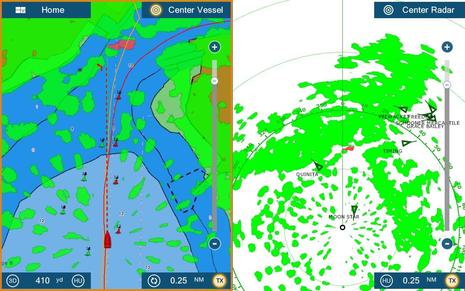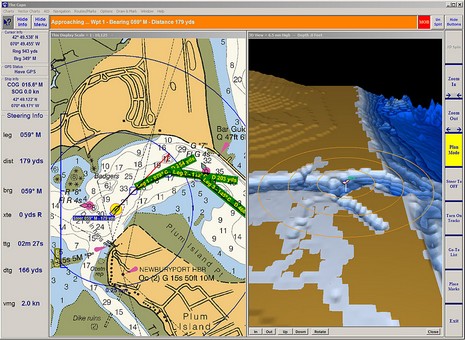To transpond or not to transpond, that is the question.

Apologies to Shakespeare. Please do open the full screen of the above, as it nicely illustrates a point I mentioned this morning…how neatly Capn Voyager plots where a Closest Point of Approach is going to happen. I like it and I don’t recall seeing it done before, either with AIS or ARPA (but I certainly could have missed something).
The screen shot also illustrates another situation I’d rather simulate than actually experience in limited visibility…an 85’ motor yacht and xx’ tug coming together with me as the possible sandwich meat, worse if I slow down! Now, here’s a question. Class B AIS is just about to hit the market, likely in the $1,200–$1,500 range. But some knowledgeable people think that it doesn’t matter much for smaller boats to be sending out their position, that 90% of AIS’s value is in being able to see what the big guys are doing so you can stay the hell out of of their way. What do you think?
PS. I like software like Nobeltec and Coastal Explorer which can draw AIS targets to scale when you zoom in to an appropriate level, but notice how screwed up the dimensions of the tug Seguin are. I see user input mistakes like this all the time.













Ben,
My sense is that the big boys don’t like to give way and expect the blow boats to alter course. I have received several VHF hails and a few horn blasts from tows on LIS. The DO have right of way. Now a mega stink pot and a blow boat… my experience is that they never want to pass astern and seem to speed up and change course JUST to pass your bow.
My approach is to avoid other boats and not discuss it in court. But it would be a good idea to be trasmitting your data whilst underway. It certainly can’t hurt.
The deal is that ultimately you MUST stand watch on deck… and NOT rely on instruments for collision avoidance. You MUST use all the information including your vision, hearing and the data on the instrument displays to navigate with prudence.
Jef
sv Shiva
Contest 36s
I am not looking forward to Class B AIS at all. I want to see ships, ferries, and tugs. There is enough AIS clutter from ships at the dock and anchor without signals from 30 foot motorboats.
My guess is that the big boys will filter out the class B signals and the rest of us will learn to avoid them.
I like the graphical display of a potential collision point that Sea Clear II has.
Here’s a screen shot of what I experienced in the Singapore Straits:
http://yachtvalhalla.net/projects/ais/sc01.jpg
On this display VALHALLA is shown as the purple circle with a projected course line and an ellipse of roughly one NM around the vessel, as determined by program settings. I was concerned about the vessel FRONT SCILLA and had selected it for tracking (as indicated by the dashed line square around that vessel).
But suddenly the display showed another vessel, ?006 (an identifier assigned by the program since it had not received all of the vessel information) with a projected intercept point ahead of both of our vessels.
This is a HIGHLY DESIRABLE feature of the SEA CLEAR II program as it graphically alerts you to dangerous situations automatically without the need to investigate the vessels around you to determine a crash potential!
I think the real question is, “is anybody listening?” If larger ships are not really designed to zig-zag around smaller vessels then how much attention will really be paid to recreational transmissions? What’s worse is if a boater was to falsely assume that transmitting would in fact protect them to the point that they let down their guard. The coast guard mandate only specifies who needs to transmit, not who needs to listen. Granted, any additional safety advantage on the water is a welcome one, but if no one can guarantee my transmission is being received, and I can pick up an receive-only AIS – providing “90% of the benefit” – at half the price, the choice seems pretty clear.
Check out the CPA warning system of SEACLEAR 2. This is close to be superior to any of the high price PC nav. programmes.
Here’s a new AIS receiver option available in the UK and France. The Icom M505 and M603 DSC VHF units have an AIS receiver built in. Output is sent to your chartplotter for display. The details are sketchy but a site in French mentions “Shipplotter, Sw&n, Maxsea etc…”. NMEA 0183 I think. The press release is here:
http://www.icomuk.co.uk/categoryRender.asp?categoryID=3508&cCID=7384
The advantages they claim are: avoid running a second antenna coax up the mast of a sailboat, avoid the constraints of multiple antenna locations, and use the excellent Icom receivers.
Thanks, Norse, but I believe the operative word here is “announced”, not “available”. I heard about this a week or so ago and am waiting on IcomUSA so I can hopefully write an entry with more detail than is available at IcomUK. Regardless, it’s great that Icom is getting into AIS, and a benefit you didn’t mention is a single connection for both DSC in/out and AIS.
Depends on what “for sale” means I guess 🙂 but clearly unless you’re in England or France it’s not even announced. I wonder if the press release was done just to claim being the first. It turns out there is another similar unit coming out at the end of Feb 2008 in France (or so they say) — the Navicom RT-650 DSC. I doubt Navicom is the OEM.
http://www.twenga.fr/offre/109733838.html (an advert, in French)
http://www.enkgroup.ee/navicom%20RT650.pdf (more info, in English)
The navicom.fr website doesn’t mention it.
Back to the Icom units. I see now that both the M505 and M603 have been available for almost two years, so it’s really confusing they’ve added an AIS feature without changing the model numbers.
Perhaps these are local mods. The website I used for the previous post has more info and photos, but I assumed they were talking about prototypes, not production models:
http://www.icom-france.com/files/DOC-AIS-fr.pdf (in French)
This describes how it may handle AIS, and you might think this is too much of a compromise. A typical Class A AIS transponder has three VHF receivers, two AIS and one DSC. A typical Class B has two AIS receivers and one doubles as a DSC receiver. The Icom units look like they have one receiver and it scans those three channels plus any other VHF channels you are monitoring. It there is traffic on a regular VHF channel, the AIS scanning stops for that. Except there are “advanced options” for use in special cases.
(The production units could be different).
Norse – I read the ICOM data the same as you – looks like a scanning receiver – so I’m not sure how it guarantees to pick up the 26ms AIS packets….
I’ve seen a prototype of the Navicom radio recently and it is quite impressive. I got a quick peek inside and it has at least 3 Receivers.